2009 GMC CANYON weight
[x] Cancel search: weightPage 239 of 414
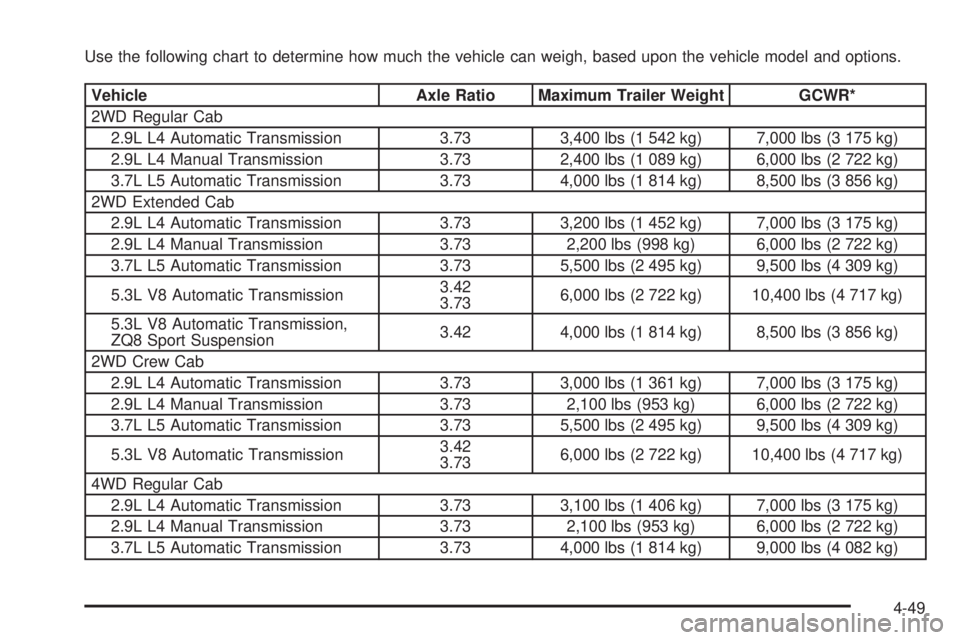
Use the following chart to determine how much the vehicle can weigh, based upon the vehicle model and options.
Vehicle Axle Ratio Maximum Trailer Weight GCWR*
2WD Regular Cab
2.9L L4 Automatic Transmission 3.73 3,400 lbs (1 542 kg) 7,000 lbs (3 175 kg)
2.9L L4 Manual Transmission 3.73 2,400 lbs (1 089 kg) 6,000 lbs (2 722 kg)
3.7L L5 Automatic Transmission 3.73 4,000 lbs (1 814 kg) 8,500 lbs (3 856 kg)
2WD Extended Cab
2.9L L4 Automatic Transmission 3.73 3,200 lbs (1 452 kg) 7,000 lbs (3 175 kg)
2.9L L4 Manual Transmission 3.73 2,200 lbs (998 kg) 6,000 lbs (2 722 kg)
3.7L L5 Automatic Transmission 3.73 5,500 lbs (2 495 kg) 9,500 lbs (4 309 kg)
5.3L V8 Automatic Transmission3.42
3.736,000 lbs (2 722 kg) 10,400 lbs (4 717 kg)
5.3L V8 Automatic Transmission,
ZQ8 Sport Suspension3.42 4,000 lbs (1 814 kg) 8,500 lbs (3 856 kg)
2WD Crew Cab
2.9L L4 Automatic Transmission 3.73 3,000 lbs (1 361 kg) 7,000 lbs (3 175 kg)
2.9L L4 Manual Transmission 3.73 2,100 lbs (953 kg) 6,000 lbs (2 722 kg)
3.7L L5 Automatic Transmission 3.73 5,500 lbs (2 495 kg) 9,500 lbs (4 309 kg)
5.3L V8 Automatic Transmission3.42
3.736,000 lbs (2 722 kg) 10,400 lbs (4 717 kg)
4WD Regular Cab
2.9L L4 Automatic Transmission 3.73 3,100 lbs (1 406 kg) 7,000 lbs (3 175 kg)
2.9L L4 Manual Transmission 3.73 2,100 lbs (953 kg) 6,000 lbs (2 722 kg)
3.7L L5 Automatic Transmission 3.73 4,000 lbs (1 814 kg) 9,000 lbs (4 082 kg)
4-49
Page 240 of 414
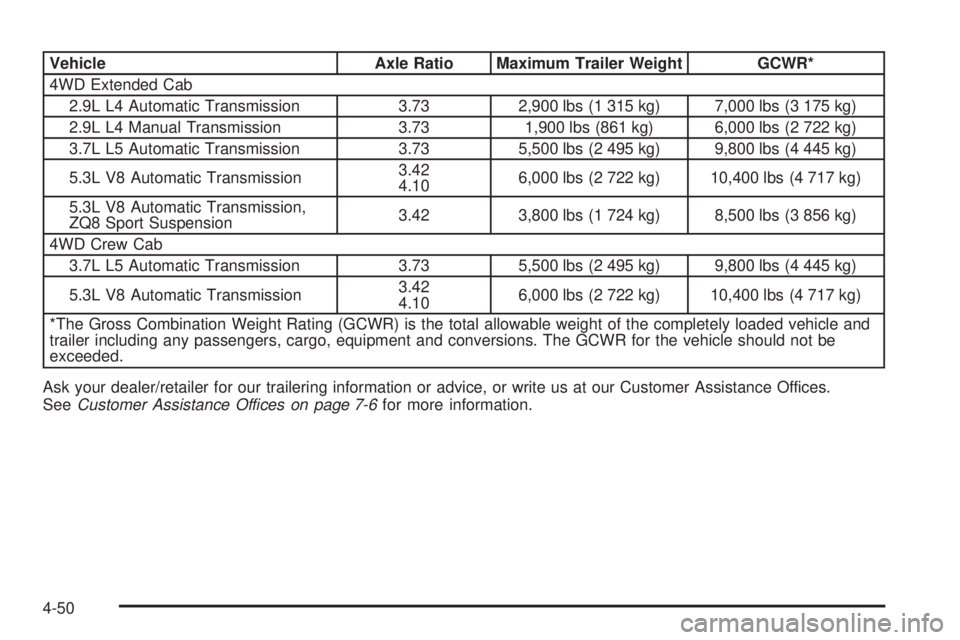
Vehicle Axle Ratio Maximum Trailer Weight GCWR*
4WD Extended Cab
2.9L L4 Automatic Transmission 3.73 2,900 lbs (1 315 kg) 7,000 lbs (3 175 kg)
2.9L L4 Manual Transmission 3.73 1,900 lbs (861 kg) 6,000 lbs (2 722 kg)
3.7L L5 Automatic Transmission 3.73 5,500 lbs (2 495 kg) 9,800 lbs (4 445 kg)
5.3L V8 Automatic Transmission3.42
4.106,000 lbs (2 722 kg) 10,400 lbs (4 717 kg)
5.3L V8 Automatic Transmission,
ZQ8 Sport Suspension3.42 3,800 lbs (1 724 kg) 8,500 lbs (3 856 kg)
4WD Crew Cab
3.7L L5 Automatic Transmission 3.73 5,500 lbs (2 495 kg) 9,800 lbs (4 445 kg)
5.3L V8 Automatic Transmission3.42
4.106,000 lbs (2 722 kg) 10,400 lbs (4 717 kg)
*The Gross Combination Weight Rating (GCWR) is the total allowable weight of the completely loaded vehicle and
trailer including any passengers, cargo, equipment and conversions. The GCWR for the vehicle should not be
exceeded.
Ask your dealer/retailer for our trailering information or advice, or write us at our Customer Assistance Offices.
SeeCustomer Assistance Offices on page 7-6for more information.
4-50
Page 241 of 414
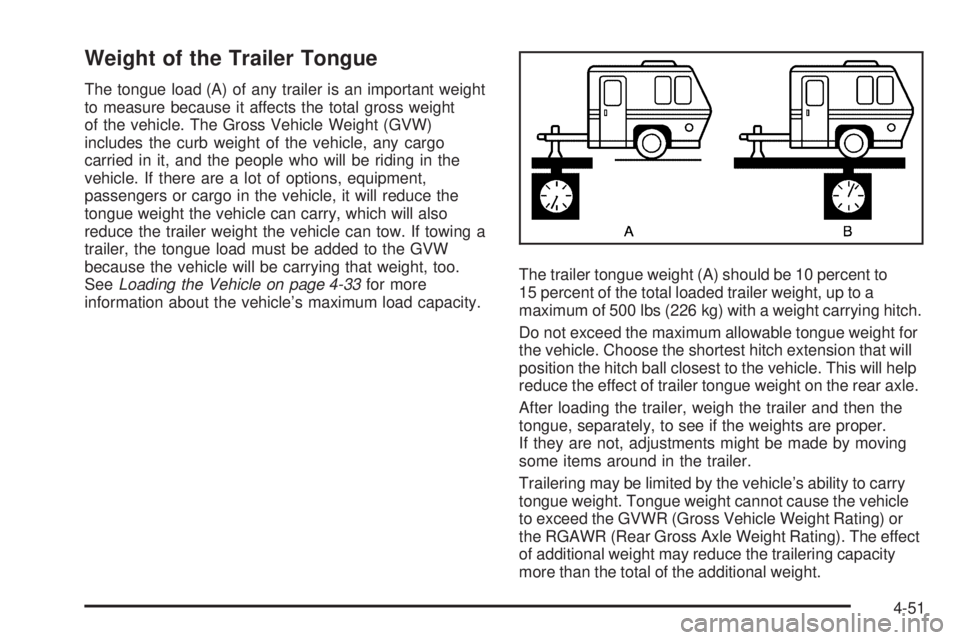
Weight of the Trailer Tongue
The tongue load (A) of any trailer is an important weight
to measure because it affects the total gross weight
of the vehicle. The Gross Vehicle Weight (GVW)
includes the curb weight of the vehicle, any cargo
carried in it, and the people who will be riding in the
vehicle. If there are a lot of options, equipment,
passengers or cargo in the vehicle, it will reduce the
tongue weight the vehicle can carry, which will also
reduce the trailer weight the vehicle can tow. If towing a
trailer, the tongue load must be added to the GVW
because the vehicle will be carrying that weight, too.
SeeLoading the Vehicle on page 4-33for more
information about the vehicle’s maximum load capacity.The trailer tongue weight (A) should be 10 percent to
15 percent of the total loaded trailer weight, up to a
maximum of 500 lbs (226 kg) with a weight carrying hitch.
Do not exceed the maximum allowable tongue weight for
the vehicle. Choose the shortest hitch extension that will
position the hitch ball closest to the vehicle. This will help
reduce the effect of trailer tongue weight on the rear axle.
After loading the trailer, weigh the trailer and then the
tongue, separately, to see if the weights are proper.
If they are not, adjustments might be made by moving
some items around in the trailer.
Trailering may be limited by the vehicle’s ability to carry
tongue weight. Tongue weight cannot cause the vehicle
to exceed the GVWR (Gross Vehicle Weight Rating) or
the RGAWR (Rear Gross Axle Weight Rating). The effect
of additional weight may reduce the trailering capacity
more than the total of the additional weight.
4-51
Page 242 of 414
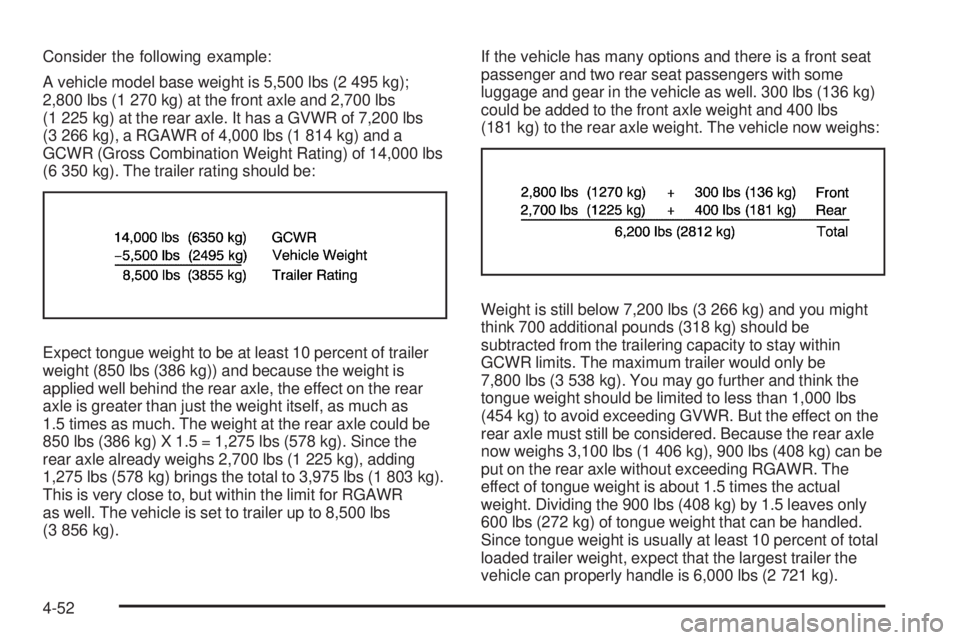
Consider the following example:
A vehicle model base weight is 5,500 lbs (2 495 kg);
2,800 lbs (1 270 kg) at the front axle and 2,700 lbs
(1 225 kg) at the rear axle. It has a GVWR of 7,200 lbs
(3 266 kg), a RGAWR of 4,000 lbs (1 814 kg) and a
GCWR (Gross Combination Weight Rating) of 14,000 lbs
(6 350 kg). The trailer rating should be:
Expect tongue weight to be at least 10 percent of trailer
weight (850 lbs (386 kg)) and because the weight is
applied well behind the rear axle, the effect on the rear
axle is greater than just the weight itself, as much as
1.5 times as much. The weight at the rear axle could be
850 lbs (386 kg) X 1.5 = 1,275 lbs (578 kg). Since the
rear axle already weighs 2,700 lbs (1 225 kg), adding
1,275 lbs (578 kg) brings the total to 3,975 lbs (1 803 kg).
This is very close to, but within the limit for RGAWR
as well. The vehicle is set to trailer up to 8,500 lbs
(3 856 kg).If the vehicle has many options and there is a front seat
passenger and two rear seat passengers with some
luggage and gear in the vehicle as well. 300 lbs (136 kg)
could be added to the front axle weight and 400 lbs
(181 kg) to the rear axle weight. The vehicle now weighs:
Weight is still below 7,200 lbs (3 266 kg) and you might
think 700 additional pounds (318 kg) should be
subtracted from the trailering capacity to stay within
GCWR limits. The maximum trailer would only be
7,800 lbs (3 538 kg). You may go further and think the
tongue weight should be limited to less than 1,000 lbs
(454 kg) to avoid exceeding GVWR. But the effect on the
rear axle must still be considered. Because the rear axle
now weighs 3,100 lbs (1 406 kg), 900 lbs (408 kg) can be
put on the rear axle without exceeding RGAWR. The
effect of tongue weight is about 1.5 times the actual
weight. Dividing the 900 lbs (408 kg) by 1.5 leaves only
600 lbs (272 kg) of tongue weight that can be handled.
Since tongue weight is usually at least 10 percent of total
loaded trailer weight, expect that the largest trailer the
vehicle can properly handle is 6,000 lbs (2 721 kg).
4-52
Page 243 of 414
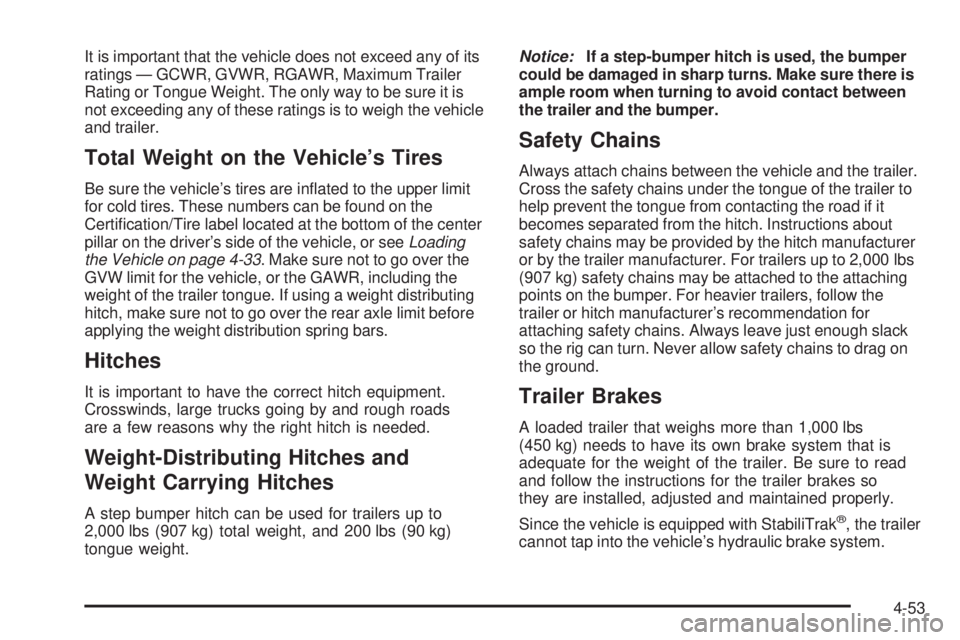
It is important that the vehicle does not exceed any of its
ratings — GCWR, GVWR, RGAWR, Maximum Trailer
Rating or Tongue Weight. The only way to be sure it is
not exceeding any of these ratings is to weigh the vehicle
and trailer.
Total Weight on the Vehicle’s Tires
Be sure the vehicle’s tires are in�ated to the upper limit
for cold tires. These numbers can be found on the
Certi�cation/Tire label located at the bottom of the center
pillar on the driver’s side of the vehicle, or seeLoading
the Vehicle on page 4-33. Make sure not to go over the
GVW limit for the vehicle, or the GAWR, including the
weight of the trailer tongue. If using a weight distributing
hitch, make sure not to go over the rear axle limit before
applying the weight distribution spring bars.
Hitches
It is important to have the correct hitch equipment.
Crosswinds, large trucks going by and rough roads
are a few reasons why the right hitch is needed.
Weight-Distributing Hitches and
Weight Carrying Hitches
A step bumper hitch can be used for trailers up to
2,000 lbs (907 kg) total weight, and 200 lbs (90 kg)
tongue weight.Notice:If a step-bumper hitch is used, the bumper
could be damaged in sharp turns. Make sure there is
ample room when turning to avoid contact between
the trailer and the bumper.
Safety Chains
Always attach chains between the vehicle and the trailer.
Cross the safety chains under the tongue of the trailer to
help prevent the tongue from contacting the road if it
becomes separated from the hitch. Instructions about
safety chains may be provided by the hitch manufacturer
or by the trailer manufacturer. For trailers up to 2,000 lbs
(907 kg) safety chains may be attached to the attaching
points on the bumper. For heavier trailers, follow the
trailer or hitch manufacturer’s recommendation for
attaching safety chains. Always leave just enough slack
so the rig can turn. Never allow safety chains to drag on
the ground.
Trailer Brakes
A loaded trailer that weighs more than 1,000 lbs
(450 kg) needs to have its own brake system that is
adequate for the weight of the trailer. Be sure to read
and follow the instructions for the trailer brakes so
they are installed, adjusted and maintained properly.
Since the vehicle is equipped with StabiliTrak
®, the trailer
cannot tap into the vehicle’s hydraulic brake system.
4-53
Page 244 of 414

Driving with a Trailer
{CAUTION:
When towing a trailer, exhaust gases may collect
at the rear of the vehicle and enter if the liftgate,
trunk/hatch, or rear-most window is open.
Engine exhaust contains carbon monoxide (CO)
which cannot be seen or smelled. It can cause
unconsciousness and even death.
To maximize safety when towing a trailer:
Have the exhaust system inspected for leaks
and make necessary repairs before starting
a trip.
Never drive with the liftgate, trunk/hatch, or
rear-most window open.
Fully open the air outlets on or under the
instrument panel.
Adjust the Climate Control system to a setting
that brings in only outside air and set the fan
speed to the highest setting. See Climate
Control System in the Index.
For more information about carbon monoxide,
seeEngine Exhaust on page 2-35.Towing a trailer requires a certain amount of experience.
Get to know the rig before setting out for the open road.
Get acquainted with the feel of handling and braking with
the added weight of the trailer. And always keep in mind
that the vehicle you are driving is now longer and not as
responsive as the vehicle is by itself.
Before starting, check all trailer hitch parts and
attachments, safety chains, electrical connectors, lamps,
tires and mirror adjustments. If the trailer has electric
brakes, start the vehicle and trailer moving and then
apply the trailer brake controller by hand to be sure the
brakes are working. This checks the electrical connection
at the same time.
During the trip, check occasionally to be sure that the
load is secure, and that the lamps and any trailer brakes
are still working.
While towing a trailer or when exposed to long periods
of sunshine, the �oor of the truck bed may become
very warm. Avoid putting items in the truck bed
that might be affected by high ambient temperatures.Following Distance
Stay at least twice as far behind the vehicle ahead as
you would when driving the vehicle without a trailer.
This can help to avoid situations that require heavy
braking and sudden turns.
4-54
Page 247 of 414

Leaving After Parking on a Hill
1. Apply and hold the brake pedal while you:
Start the engine
Shift into a gear
Release the parking brake
2. Let up on the brake pedal.
3. Drive slowly until the trailer is clear of the chocks.
4. Stop and have someone pick up and store the
chocks.
Maintenance When Trailer Towing
The vehicle needs service more often when pulling a
trailer. SeeScheduled Maintenance on page 6-4or the
Index for more information. Things that are especially
important in trailer operation are automatic transmission
�uid, engine oil, axle lubricant, belts, cooling system and
brake system. It is a good idea to inspect these before
and during the trip.
Check periodically to see that all hitch nuts and bolts
are tight.
Trailer Wiring Harness
The vehicle may be equipped with a four-pin trailer
towing harness. This harness has a four-pin trailer
connector that is attached to a bracket on the hitch
platform. The four-wire harness contains the following
trailer circuits:
Yellow: Left Stop/Turn Signal
Green: Right Stop/Turn Signal
Brown: Taillamps/Park lamps
White: Ground
Trailer Recommendations
Subtract the hitch loads from the Cargo Weight Rating
(CWR). CWR is the maximum weight of the load the
vehicle can carry. It does not include the weight of the
people inside, but you can �gure about 150 lbs. (68 kg)
for each passenger. The total cargo load must not be
more than the vehicles CWR.
Weigh the vehicle with the trailer attached, so the GVWR
or GAWR are not exceeded. If using a weight-distributing
hitch, weigh the vehicle without the spring bars in place.
The best performance is obtained by correctly spreading
out the weight of the load and choosing the correct hitch
and trailer brakes.
For more information seeTowing a Trailer on page 4-47.
4-57
Page 306 of 414
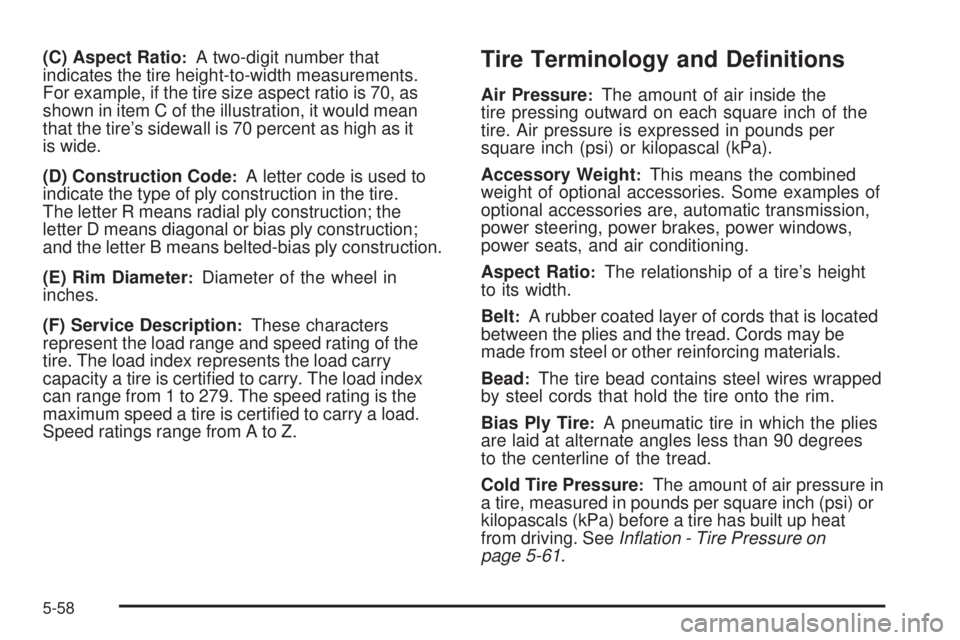
(C) Aspect Ratio:A two-digit number that
indicates the tire height-to-width measurements.
For example, if the tire size aspect ratio is 70, as
shown in item C of the illustration, it would mean
that the tire’s sidewall is 70 percent as high as it
is wide.
(D) Construction Code
:A letter code is used to
indicate the type of ply construction in the tire.
The letter R means radial ply construction; the
letter D means diagonal or bias ply construction;
and the letter B means belted-bias ply construction.
(E) Rim Diameter
:Diameter of the wheel in
inches.
(F) Service Description
:These characters
represent the load range and speed rating of the
tire. The load index represents the load carry
capacity a tire is certi�ed to carry. The load index
can range from 1 to 279. The speed rating is the
maximum speed a tire is certi�ed to carry a load.
Speed ratings range from A to Z.
Tire Terminology and De�nitions
Air Pressure:The amount of air inside the
tire pressing outward on each square inch of the
tire. Air pressure is expressed in pounds per
square inch (psi) or kilopascal (kPa).
Accessory Weight
:This means the combined
weight of optional accessories. Some examples of
optional accessories are, automatic transmission,
power steering, power brakes, power windows,
power seats, and air conditioning.
Aspect Ratio
:The relationship of a tire’s height
to its width.
Belt
:A rubber coated layer of cords that is located
between the plies and the tread. Cords may be
made from steel or other reinforcing materials.
Bead
:The tire bead contains steel wires wrapped
by steel cords that hold the tire onto the rim.
Bias Ply Tire
:A pneumatic tire in which the plies
are laid at alternate angles less than 90 degrees
to the centerline of the tread.
Cold Tire Pressure
:The amount of air pressure in
a tire, measured in pounds per square inch (psi) or
kilopascals (kPa) before a tire has built up heat
from driving. SeeInflation - Tire Pressure on
page 5-61.
5-58